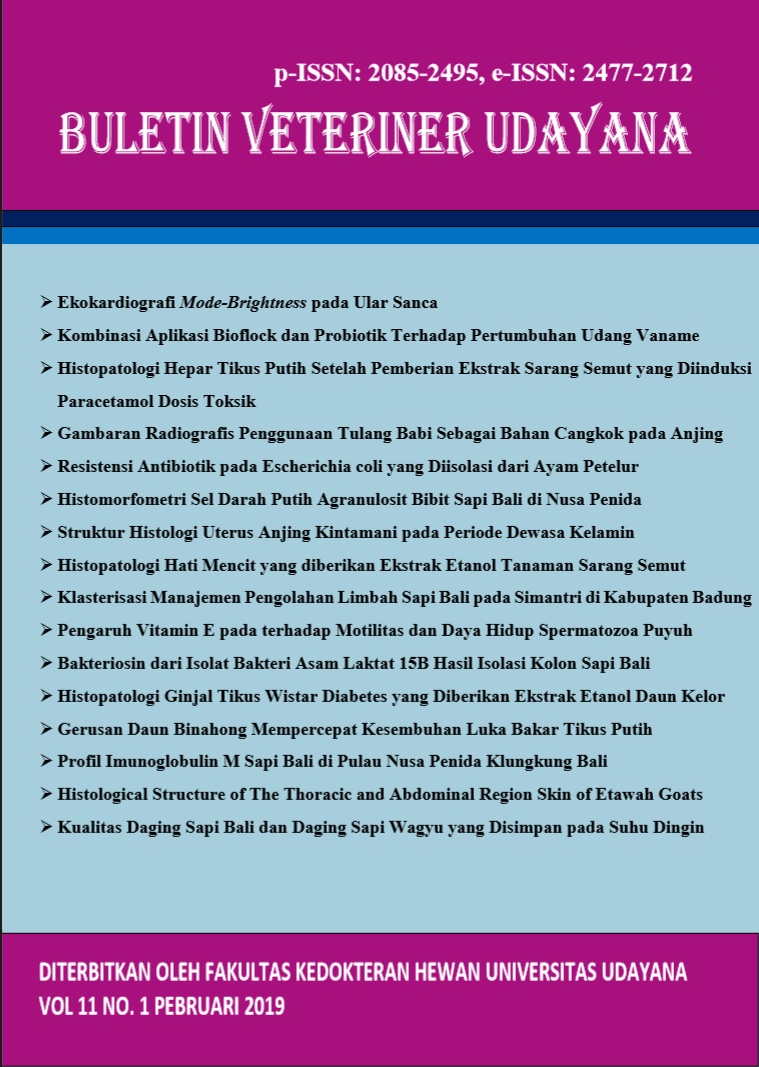HISTOPATHOLOGICAL CHANGES OF MICE LIVER THAT INDUCED BY ETHANOL EXTRACT OF ANT NEST TREE
Abstract
Anthill plants attracted many people as an alternative medicine because proven efficacious for treating tumor diseases, cancer, tuberculosis, stroke, coronary heart disease, diabetes mellitus, nosedleeds, ulcer, hemorrhoids, facilitate breastfeeding, increase stamina and sexual arousal. This study aimed to determine the effect of ethanol extract of the anthill plant to the mice liver histopathology. This study is an experimental laboratory. Twenty fourth male mice 10-12 weeks of age with a body weight of 25-35 grams were divided into 4 groups, each group consisting of 6 mice were given treatment that Control Group, Group I (doses 100mg/kg BW), Group II (doses 200mg/kg BW) and Group III (doses 300mg/kg BW) for 21 days. Hepatic histopathological changes were observed and assessed by histological damage in the form of infiltration of inflammatory cells, lipid degeneration and necrosis. Data were analyzed using statistical test of Kruskal-Wallis followed with Mann-Whitney Test (p<0.05). Kruskal-Wallis test result showed ethanol extract anthill very significant (p<0.01) effect on the incident of lipid degeneration, necrosis and infiltration of inflammatory cell of liver cells. Based on these result it can be concluded that the ethanol extract of anthill can cause histological changes in the liver of mice.
Downloads
References
Ariani SRD, Irianto H, Malikhah I. 2014. Optimasi lama waktu ekstraksi guna menghasilkan ekstrak herba sarang semut (Myrmecodia Pendans Merr. & Perry) dari kalteng dengan aktivitas antioksidan tertinggi disertai skrining senyawa bahan alam. Seminar Nasional Kimia dan Pendidikan Kimia IV.
Corwin EJ. 2001. Buku Saku Patofisiologi. (Diterjemahkan Brahmu). Penerbit Buku Kedokteran, EGC. Jakarta.
Guyton AC, Hall JE. 1997. Buku Ajar Fisiologi Kedokteran. Penerbit Buku Kedokteran, EGC. Jakarta.
Kardena IM, Winaya IBO. 2011. Kadar perasan kunyit yang efektif memperbaiki kerusakan hepar mencit yang dipicu karbon tetrachlorida. J. Vet., 12(1): 34-39.
Kurniawan IWAY, Wiratmini NI, Sudatri NW. 2014. Histologi hepar mencit (Mus Musculus L.) yang diberi ekstrak daun lamtoro (Leucaena leucocephala). J. Simbiosis, 2(2): 226- 235.
Lamondo D, Soegianto A, Abadi A, Keman S. 2014. Antioxidant effects of sarang semut (Myrmecodia pendans) on the apoptosis of spermatogenic cells of rats exposed to plumbum. Res. J. Pharm. Biol. Chem. Sci., 5(4): 282-294.
Retnowati Y, Uno WD, SR Rahman. 2012. Isolasi mikroba endofit tanaman sarang semut (Myrmecodia Pendens) dan analisis potensi sebagai antimikroba. Laporan Penelitian Pengembangan IPTEK. Universitas Gorontalo.
Roslizawaty, Budiman H, Laila H, Herrialfian. 2013. Pengaruh ekstrak etanol sarang semut (Myrmecodia Sp.) terhadap gambaran histopatologi ginjal mencit (Mus Musculus) jantan yang hiperurisemia. J. Med. Vet., 7(2):116-120.
Sari LORK. 2006. Pemanfaatan obat tradisional dengan pertimbangan manfaat dan keamanannya. Majalah Ilmu Kefarmasian, 3(1): 1-7.
Sari PK, Lintong PM, Loho LL. 2015. Efek pemberian anabolik androgenik steroid injeksi dosis rendah dan tinggi terhadap gambaran histopatologi hepar dan otot rangka tikus wistar (Rattus Novergicus). J. e-Biomedik. 3(1): 501-509.
Soeksmanto A, Simanjuntak P, Subroto MA. 2010.. Uji toksisitas akut ekstrak air tanaman sarang semut (Myrmecodia pendans) terhadap histologi organ hepar mencit. J. Natur Indonesia, 12(2): 152-155.
Swarayana IMI, Sudira IW, Berata IK. 2012. Perubahan histopatologi hepar mencit (Mus musculus) yang diberikan ekstrak daun ashitaba (Angelica keiskei). Bul. Vet. Udayana, 4(2): 119-125.
Tatukude P, Loho L, Lintong P. 2014. Gambaran histopatologi hepar mencit swiss yang diberi air rebusan sarang semut (Mymercodia pendans) paska induksi dengan carbon tetrachlorida (Ccl4). J. e-Biomedik. 2(2): 459-466.





